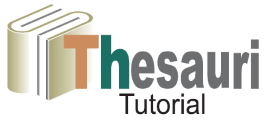The aim of the section is to provide a methodology on how to create thesauri concepts in order to facilitate successful searches that will reveal as many of the concepts as possible that are relevant to the research questions posed by domain experts. It helps to ensure the intersubjective and interdisciplinary character of its implementation without forcing the experts to abandon their own terminology.
Some of the issues that thesauri designers have to deal with when developing thesauri concepts include:
- How to achieve the greatest possible accessibility and interoperability of the thesauri. In other words, how to search for a specific term related to a particular science, without presuming beforehand knowledge of the terms of this particular science.
- How to avoid the subjective classification of the terms so as to ensure its validity which will enable users to access the information that may have an impact on their research regardless of their backgrounds and knowledge.
- How to ensure that users can find, learn, understand and use the terms needed for their research inquiries with a reasonable effort and efficiency.
- How to achieve the greatest economy in the process of recording and indexing the terms.
- How to avoid the logical errors or idiosyncratic decisions, which will lead to inconsistencies and consequently would require backwards-incompatible restructuring of classification systems and their application.
In order to deal with such issues we have formulated guidelines that A) would aid users to create effective thesauri concepts and B) help them to classify terms on the basis of the typical criteria.
The proposed guidelines included in this section are the outcome of an effort by a team of experts [1] of designing and building effective and efficient classification systems for research infrastructures in the humanities [2], based on a consistent methodology which could ensure the intersubjective and interdisciplinary character of its implementation without forcing the experts to abandon their own terminology. Our work focuses on identifying the top-level-concepts (facets and hierarchies) that will become a common basis for thesaurus building, meeting the demands for objectivity and interdisciplinarity. The methodology we propose is based on the principle of faceted classification and the idea that a limited number of top-level concepts can become a substantial tool to harmonize the numerous discipline and even project specific terminologies into a coherent and effective federation . The method foresees the development of concepts from existing scientific terms by a process of abstraction according to a bottom-up approach. It allows us to exploit all the advantages offered by categorical semantics and to detect the intensional and potential properties of the general concepts under which we can subsume more specific terms.
[1] Martin Doerr, Maria Daskalaki, Lida Charami, Chryssoula Bekiari, Helen Katsiadaki, Helen Goulis, Makis Chrisovitsanos, Georgia Papadopoulou, Iraklitos Souyioultzoglou, Hella Hollander, Vanessa Hannesschläger, Wolfgang Schmidle.
[2] Dariah EU, VCC3. Thesaurus Maintenance Working Group: A model for sustainable interoperable thesauri maintenance.





